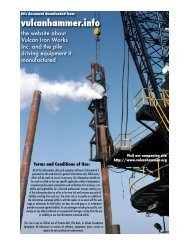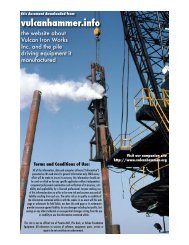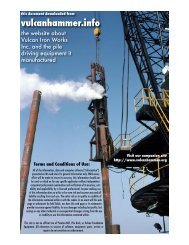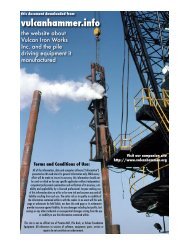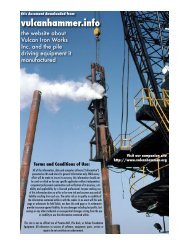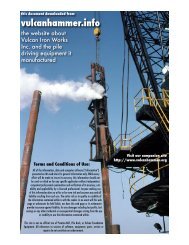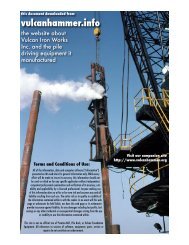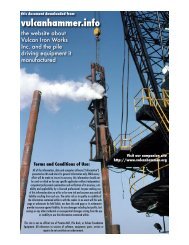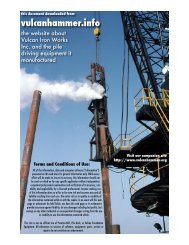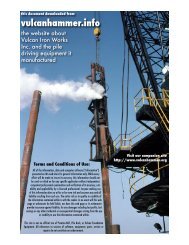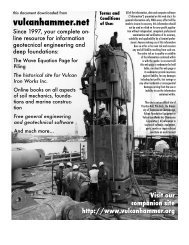Design and Performance of an Electro-Pneumatic Pile Hammer for ...
Design and Performance of an Electro-Pneumatic Pile Hammer for ...
Design and Performance of an Electro-Pneumatic Pile Hammer for ...
- No tags were found...
You also want an ePaper? Increase the reach of your titles
YUMPU automatically turns print PDFs into web optimized ePapers that Google loves.
this document downloaded fromvulc<strong>an</strong>hammer.netSince 1997, your complete onlineresource <strong>for</strong> in<strong>for</strong>mationgeotecnical engineering <strong><strong>an</strong>d</strong>deep foundations:The Wave Equation Page <strong>for</strong>PilingThe historical site <strong>for</strong> Vulc<strong>an</strong>Iron Works Inc.Online books on all aspects<strong>of</strong> soil mech<strong>an</strong>ics, foundations<strong><strong>an</strong>d</strong> marine constructionFree general engineering<strong><strong>an</strong>d</strong> geotechnical s<strong>of</strong>twareAnd much more...Terms <strong><strong>an</strong>d</strong>Conditions<strong>of</strong> Use:All <strong>of</strong> the in<strong>for</strong>mation, data <strong><strong>an</strong>d</strong> computer s<strong>of</strong>tware(“in<strong>for</strong>mation”) presented on this web site is <strong>for</strong>general in<strong>for</strong>mation only. While every ef<strong>for</strong>t will bemade to insure its accuracy, this in<strong>for</strong>mation shouldnot be used or relied on <strong>for</strong> <strong>an</strong>y specific applicationwithout independent, competent pr<strong>of</strong>essionalexamination <strong><strong>an</strong>d</strong> verification <strong>of</strong> its accuracy,suitability <strong><strong>an</strong>d</strong> applicability by a licensed pr<strong>of</strong>essional.Anyone making use <strong>of</strong> this in<strong>for</strong>mationdoes so at his or her own risk <strong><strong>an</strong>d</strong> assumes<strong>an</strong>y <strong><strong>an</strong>d</strong> all liability resulting from such use.The entire risk as to quality or usability<strong>of</strong> the in<strong>for</strong>mation contained withinis with the reader. In no event willthis web page or webmaster be heldliable, nor does this web page orits webmaster provide insur<strong>an</strong>ceagainst liability, <strong>for</strong> <strong>an</strong>y damagesincluding lost pr<strong>of</strong>its, lost savings or<strong>an</strong>y other incidental or consequentialdamages arising from the use orinability to use the in<strong>for</strong>mationcontained within.This site is not <strong>an</strong> <strong>of</strong>ficial site <strong>of</strong>Prentice-Hall, <strong>Pile</strong> Buck, the University<strong>of</strong> Tennessee at Chatt<strong>an</strong>ooga,Vulc<strong>an</strong> Foundation Equipment orVulc<strong>an</strong> Iron Works Inc. (TennesseeCorporation). All references tosources <strong>of</strong> s<strong>of</strong>tware, equipment,parts, service or repairs do notconstitute <strong>an</strong> endorsementVisit ourcomp<strong>an</strong>ion sitehttp://www.vulc<strong>an</strong>hammer.org
ISKANDER ET AL. ON PILE HAMMERS 73• The hammer must be robust.• It must be possible to h<strong><strong>an</strong>d</strong>le the hammer using light hoistingequipment.• The ram velocity must r<strong>an</strong>ge between 2 to 3 m/s (7 to 10 ft/s)to satisfy the requirements <strong>of</strong> impact driving <strong><strong>an</strong>d</strong> minimize thelikelihood <strong>of</strong> damage to the pile instrumentation.Selection <strong>of</strong> <strong>Hammer</strong> TypeFIG. 1—Single <strong><strong>an</strong>d</strong> double length hammer designs.Initial consideration was given to use <strong>of</strong> a high-speed electromagnetichammer (Gills 1988), but such systems c<strong>an</strong>not h<strong><strong>an</strong>d</strong>le theneeded ram weight, <strong><strong>an</strong>d</strong> the high electric fields associated withlarge electromagnets would make the use <strong>of</strong> electronic data recordingsystems difficult. Internal combustion (diesel) hammers wereeliminated due to air pollution problems. Double-acting <strong><strong>an</strong>d</strong> differentialair hammers were considered, but <strong>an</strong>alyses showed that theywould be too heavy to be h<strong><strong>an</strong>d</strong>led conveniently in the laboratory. Asingle-acting air-operated system was selected. The penalty wasthe inability to achieve high frequencies, but the adv<strong>an</strong>tages includeda robust system <strong>of</strong> reasonable height <strong><strong>an</strong>d</strong> weight, <strong><strong>an</strong>d</strong> theneeded driving energy.FIG. 2—Schematic <strong>of</strong> hammer <strong><strong>an</strong>d</strong> leads.
74 GEOTECHNICAL TESTING JOURNALMost external combustion (steam or air-operated) hammershave a double-length design, while internal combustion (diesel)hammers have a single-length design (Fig. 1). The ram <strong>of</strong> a double-lengthhammer is lifted using a piston in <strong>an</strong> upper chamber.Pressure control valves are located at the base <strong>of</strong> the pressurechamber. The adv<strong>an</strong>tage <strong>of</strong> a double-length design is that thelength <strong>of</strong> the pressure chamber c<strong>an</strong> be made slightly longer th<strong>an</strong>the stroke <strong>of</strong> the ram to prevent the piston from impacting the bottom<strong>of</strong> the chamber <strong><strong>an</strong>d</strong> damaging the control valves. In a singlelengthdesign, the hammer consists <strong>of</strong> a single chamber in whichthe ram is lifted by direct pressure <strong><strong>an</strong>d</strong> then dropped to impact <strong>an</strong><strong>an</strong>vil at the bottom <strong>of</strong> the chamber. The limited laboratory headclear<strong>an</strong>ce <strong>for</strong>ced the use <strong>of</strong> a single-length design <strong><strong>an</strong>d</strong> thus requiredthat the control valves be mounted separately from thehammer.Reduction <strong>of</strong> cushioning during impact, due to the development<strong>of</strong> a backpressure ahead <strong>of</strong> the ram, is achieved in commercialhammers by minimizing the ram’s cross-sectional area. The typicallength-to-diameter ratio <strong>of</strong> most production hammers is around10:1. Limited head clear<strong>an</strong>ce in the laboratory required the use <strong>of</strong> alarge-diameter ram in order to maximize the available stroke, thusresulting in a hammer with a 4:1 length-to-diameter ratio.Airflow in commercial hammers is typically controlled usingmech<strong>an</strong>ical trip valves. An electrical control system was chosen <strong>for</strong>our laboratory hammer because it provides a more versatile control<strong>of</strong> the hammer’s energy <strong><strong>an</strong>d</strong> operating frequency.Layout <strong>of</strong> the Driving SystemThe driving system consists <strong>of</strong> three components: the hammer(Figs. 2 <strong><strong>an</strong>d</strong> 3), a set <strong>of</strong> leads (Figs. 2 <strong><strong>an</strong>d</strong> 3), <strong><strong>an</strong>d</strong> <strong>an</strong> external controlunit which also provides the compressed air (Fig. 4).FIG. 4—Photograph <strong>of</strong> the control unit.The <strong>Hammer</strong>The hammer (Fig. 5) consists <strong>of</strong> a stainless steel ram whichslides in <strong>an</strong> aluminum pressure chamber to impact <strong>an</strong> <strong>an</strong>vil at thebase <strong>of</strong> the chamber. The pressure chamber consists <strong>of</strong> a cylinder,top plate, <strong><strong>an</strong>d</strong> the <strong>an</strong>vil, which are held together using four stainlesssteel tie rods. The radial clear<strong>an</strong>ce between the ram <strong><strong>an</strong>d</strong> the cylinderis 0.6 mm (0.025 in.). The ram contains a central ball bushing,which slides on a hardened steel rod, to prevent it from wobbling.The hardened rod is fixed in the top plate <strong><strong>an</strong>d</strong> in the <strong>an</strong>vil.In <strong>an</strong> upstroke, air is introduced at the base <strong>of</strong> the chamberthrough the air ports in the <strong>an</strong>vil. The air supply is shut <strong>of</strong>f be<strong>for</strong>ethe ram reaches its maximum stroke. In a downstroke, the ram fallsfreely under gravity. During upstrokes, air is exhausted ahead <strong>of</strong>the ram through six exhaust ports in the top plate <strong><strong>an</strong>d</strong> twelve moreports located at two levels in the sides <strong>of</strong> the cylinder. Duringdownstrokes, air is exhausted ahead <strong>of</strong> the ram through the pneumaticcontrol system <strong><strong>an</strong>d</strong> by blow-by between the ram <strong><strong>an</strong>d</strong> the wall<strong>of</strong> the cylinder.FIG. 3—Photograph <strong>of</strong> hammer sliding on its leads during driving.The <strong>Hammer</strong> Leads (Guide System)The hammer leads hold the pile <strong><strong>an</strong>d</strong> hammer in proper alignmentto prevent eccentric hammer blows. The leads consist <strong>of</strong> two alu-
ISKANDER ET AL. ON PILE HAMMERS 75Wave Equation Analyses—Conventional soil properties used inwave equation <strong>an</strong>alyses are generally obtained from back <strong>an</strong>alyses<strong>of</strong> field case histories. Conditions in a test t<strong>an</strong>k differ from those inthe field, so properties obtained from field measurements may notnecessarily apply as well in the test t<strong>an</strong>k.A two-step procedure was used in selecting the properdesign parameters. First, wave equation <strong>an</strong>alyses were per<strong>for</strong>med<strong>for</strong> the driving conditions <strong>of</strong> the pile tested by Ugaz (1988) at theUniversity <strong>of</strong> Houston using the computer program WEAP87,<strong><strong>an</strong>d</strong> the values <strong>of</strong> quakes <strong><strong>an</strong>d</strong> damping factors that are recommended<strong>for</strong> full-scale piles (GRL 1987). The capacity measuredby Ugaz averaged twice the capacity from wave equation<strong>an</strong>alyses <strong>for</strong> the same pile set. Next, we assumed that wave equation<strong>an</strong>alyses could be applied <strong>for</strong> piles in our test t<strong>an</strong>k, usingthe same wave equation parameters as used above, but with thewave equation capacity equal to half <strong>of</strong> the <strong>an</strong>ticipated static capacity.Multiple wave equation <strong>an</strong>alyses were then per<strong>for</strong>med toobtain the optimum dimensions <strong><strong>an</strong>d</strong> weights <strong>of</strong> the mech<strong>an</strong>icalcomponents <strong>of</strong> the pile hammer being designed. These <strong>an</strong>alysesresulted in the selection <strong>of</strong> the hammer specifications shown inTable 1.The ram weight is relatively large, compared with the pileweight, because the s<strong><strong>an</strong>d</strong> in the test chamber is subjected to a largeconfining pressure. The usual rule <strong>of</strong> thumb is that the ram weightshould be approximately equal to the weight <strong>of</strong> the pile beingdriven (Fleming et al. 1985). However, wave equation <strong>an</strong>alysis <strong>of</strong>the driving conditions in a test chamber indicates that a ram weighingtwo to six times the weight <strong>of</strong> the pile is required.FIG. 5—Cross section through the hammer.minum guide rails connected to a high-density polyethylene(HDPE) guide block (Fig. 2). The block is secured to the pressurechamber’s loading frame using <strong>an</strong> aluminum ch<strong>an</strong>nel (Fig. 6). Asthe pile penetrates into the soil, the hammer slides on the guide railsthrough two low friction HDPE bushings <strong><strong>an</strong>d</strong> follows the pile.The Control UnitThe control unit (Fig. 4) contains the electronic <strong><strong>an</strong>d</strong> pneumaticcontrols. Compressed air used to lift the ram is provided froma solenoid valve, located in the control unit. A function generatorcontrols the solenoid valve <strong><strong>an</strong>d</strong> thus controls the operatingfrequency <strong><strong>an</strong>d</strong> stroke <strong>of</strong> the hammer.<strong>Design</strong> <strong>of</strong> the <strong>Hammer</strong>The following is a summary <strong>of</strong> the hammer design philosophy.Detailed <strong>an</strong>alyses, shop drawings, <strong><strong>an</strong>d</strong> component model numbersc<strong>an</strong> be found in Isk<strong><strong>an</strong>d</strong>er (1995).Mech<strong>an</strong>ical <strong>Design</strong>Wave equation <strong>an</strong>alysis was used to determine the weights, materials,<strong><strong>an</strong>d</strong> dimensions <strong>of</strong> the ram, <strong>an</strong>vil, <strong><strong>an</strong>d</strong> cushions. A separate<strong>an</strong>alysis was per<strong>for</strong>med to study the <strong>for</strong>ce-time signal <strong><strong>an</strong>d</strong> determinethe dwell time <strong>of</strong> contact between the ram <strong><strong>an</strong>d</strong> the <strong>an</strong>vil.FIG. 6—<strong>Hammer</strong> mounted on leads <strong><strong>an</strong>d</strong> test frame.
76 GEOTECHNICAL TESTING JOURNALTABLE 1—<strong>Hammer</strong> specifications.Item SI EnglishGeneralRated energy 0.21 J 156 ft-lbNormal operating 1 Hz 60 BPMfrequencyMaximum operating 1.2 Hz 72 BPMfrequencyTotal weight 645 N 145 lbEfficiency 57–66% 57–66%Ram (Stainless steel)Weight 38 kg 85 lbYoung’s Modulus 196 500 MPa 28 500 ksiOD 208 mm 8.2 in.ID 20–32 mm 0.8–1.25 in.Height 152 mm 6 in.Normal Stroke 560 mm 22 in.Maximum Stroke 610 mm 24 in.Anvil (Aluminum)Weight 13 kg 30 lb.Young’s modulus 69 000 MPa 10 000 ksiDimensions 229 229 9 9 3 in.76 mm<strong>Hammer</strong> Cushion (Nylon)Young’s modulus 2413 MPa 350 ksiThickness 1.6 mm 0.0625 in.Diameter 114 mm 4.5 in.<strong>Pile</strong> Cushion (Nylon)Young’s modulus 2413 MPa 350 ksiThickness 1.6 mm 0.0625 in.OD 102 4.0 in.ID 63.5 mm 2.5Dwell Time—In field applications, the main part <strong>of</strong> the hammerenergy is delivered to the pile in a time less th<strong>an</strong> the time <strong>of</strong> wavepropagation to the pile tip <strong><strong>an</strong>d</strong> back, t*. <strong>Pile</strong>s driven in our testchamber have lengths <strong>of</strong> 0.81 to 0.91 m (32 to 36 in.). For a wavespeed, c, <strong>of</strong> 5000 m/s (16 400 ft/s) in stainless steel, the correspondingwave travel times, t*, are 0.33 to 0.37 ms. The goal wasthen to ensure that the time <strong>of</strong> contact between the ram <strong><strong>an</strong>d</strong> <strong>an</strong>vil(dwell time) is less th<strong>an</strong> 0.33 ms.The dwell time, t d , c<strong>an</strong> be approximated as half <strong>of</strong> the natural period<strong>of</strong> a system consisting <strong>of</strong> a mass impacting a spring resting ona rigid base (Warrington 1987):mt d (1)k ewhere m is the mass <strong>of</strong> the ram <strong><strong>an</strong>d</strong> k e is the equivalent stiffness <strong>of</strong>the ram cushion, <strong>an</strong>vil, <strong><strong>an</strong>d</strong> pile cushion. Stiffnesses are defined as:k E A (2)Lwhere E is Young’s modulus, A is area, <strong><strong>an</strong>d</strong> L is length <strong>of</strong> the element.The equivalent stiffness, k e , is given by:k P k R k Ak e (3)k P k R k R k A k P k Awhere k P is the stiffness <strong>of</strong> the pile cushion, k A is the stiffness <strong>of</strong> the<strong>an</strong>vil, <strong><strong>an</strong>d</strong> k R is the stiffness <strong>of</strong> the ram cushion. Using the proper-ties shown in Table 1, the calculated dwell time, t d , was 0.3 ms,which is shorter th<strong>an</strong> the time <strong>for</strong> the wave to travel to the tip <strong><strong>an</strong>d</strong>return <strong><strong>an</strong>d</strong> is thus considered acceptable.The dwell time calculated using Eqs 1 to 3 neglects the pile stiffness<strong><strong>an</strong>d</strong> is only valid <strong>for</strong> a hammer resting on a rigid system. Deeks<strong><strong>an</strong>d</strong> R<strong><strong>an</strong>d</strong>olph (1993) developed <strong>an</strong> alternative <strong>an</strong>alytical modelthat uses springs <strong><strong>an</strong>d</strong> dash pots to represent the pile <strong><strong>an</strong>d</strong> cushions<strong><strong>an</strong>d</strong> lumped masses to represent the ram <strong><strong>an</strong>d</strong> <strong>an</strong>vil. The model wasmathematically unstable <strong>for</strong> the masses <strong><strong>an</strong>d</strong> stiffnesses <strong>of</strong> our system,which are 2 to 4 orders <strong>of</strong> magnitude different from those <strong>of</strong>commercial hammers.<strong>Design</strong> <strong>of</strong> the <strong>Electro</strong>-<strong>Pneumatic</strong> Control SystemAmeric<strong>an</strong> suppliers <strong>of</strong> pneumatic components utilize experimentallyderived capacity coefficients, c v , to describe the flowproperties <strong>of</strong> their products (Miller 1984). Capacity coefficients areusually reported in the literature as <strong>an</strong> index, without units, but actuallyhave units <strong>of</strong> flow measured in gallons per minute <strong>of</strong> waterat 60°F under a pressure drop <strong>of</strong> 1 psi (Considine 1957). Equivalentcoefficients in metric <strong><strong>an</strong>d</strong> SI units were presented by Zappe(1987). We will follow convention in the field <strong><strong>an</strong>d</strong> report values <strong>of</strong>c v without units. However, the values <strong>of</strong> c v must then be calculatedusing the units specified in the equations, <strong><strong>an</strong>d</strong> embedded const<strong>an</strong>tsare understood to have units that cause the equations to be dimensionallycorrect.In current Americ<strong>an</strong> industry, gas volumes are specified at ast<strong><strong>an</strong>d</strong>ard temperature <strong>of</strong> 16°C (60°F) <strong><strong>an</strong>d</strong> a st<strong><strong>an</strong>d</strong>ard pressure <strong>of</strong> 1atm. Tables from U.S. suppliers use the English system <strong>of</strong> units.St<strong><strong>an</strong>d</strong>ard volume is expressed in English units as st<strong><strong>an</strong>d</strong>ard cubicfeet (SCF) <strong><strong>an</strong>d</strong> flow is st<strong><strong>an</strong>d</strong>ard cubic feet per minute (SCFM). Inthis paper, st<strong><strong>an</strong>d</strong>ard volume is also reported in st<strong><strong>an</strong>d</strong>ard cubic meters(SCM) <strong><strong>an</strong>d</strong> flow in st<strong><strong>an</strong>d</strong>ard cubic meters per second (SCMS).Required Capacity Coefficient—For computations involving exhaustinga pneumatic chamber, like the hammer chamber, capacitycoefficients are usually expressed as (Parker 1991):c v a S A C (4)T 29wherea area <strong>of</strong> the chamber (sq. in.),S stroke (in.),A const<strong>an</strong>t <strong>for</strong> pressure drop (from m<strong>an</strong>ufacturer’s tables,e.g., Parker 1991),C compression factor (from m<strong>an</strong>ufacturer’s tables, e.g.,Parker 1991), <strong><strong>an</strong>d</strong>T stroke time (seconds).To select <strong>an</strong>y component <strong>of</strong> a pneumatic system, first the requiredcapacity coefficient, c v , is determined using Eq 4. Next, acomponent is selected from the pool <strong>of</strong> commercial components,such that the capacity coefficient <strong>of</strong> the selected component islarger th<strong>an</strong> that required.In a downstroke, cushioning <strong>of</strong> the ram due to the <strong>for</strong>mation <strong>of</strong> abackpressure is minimized by ensuring that air is capable <strong>of</strong> exhaustingin less time th<strong>an</strong> is needed <strong>for</strong> the hammer to fall freelyunder gravitational pull. The time, t, required by the ram to travelthe dist<strong>an</strong>ce, s, from the bottom <strong>of</strong> the exhaust ports to the <strong>an</strong>vil, underuni<strong>for</strong>m gravitational acceleration, g, is given by:t 2 s (5)g
ISKANDER ET AL. ON PILE HAMMERS 77For a stroke <strong>of</strong> 550 mm (22 in.), the travel time <strong>of</strong> the ram duringthe downstroke is 0.34 s. A corresponding capacity coefficient,c v , <strong>of</strong> 29.6 is obtained by substituting the stroke time, hammer dimensions,<strong><strong>an</strong>d</strong> assuming <strong>an</strong> inlet pressure <strong>of</strong> 69 kPa (10 psi), <strong><strong>an</strong>d</strong> apressure drop <strong>of</strong> 14 kPa (2 psi) across the system in Eq 4. Accordingly,all pneumatic components should have a minimum exhaustc v <strong>of</strong> 30 to minimize cushioning.The <strong>Electro</strong>-<strong>Pneumatic</strong> Circuit—The hammer is powered bycompressed air from a 75 mm (3 in.) diameter main at a peak pressure<strong>of</strong> about 690 kPa (100 psi). The air is supplied to the controlunit through two 12.5 mm (0.5 in.) lines, each with a 0.04 SCMS(80 SCFM) flow capacity (Fig. 7). At the control unit, compressedair is stored in a 0.23 m 3 (60 gal) t<strong>an</strong>k, which functions as a bufferto maintain a const<strong>an</strong>t supply pressure during driving.At the control unit, compressed air flowing to the hammer passesthrough a 40 m filter followed by a high-flow pressure regulator<strong><strong>an</strong>d</strong> a solenoid valve. The pressure drop across the filter was about14 kPa (2 psi) at the r<strong>an</strong>ge <strong>of</strong> operating flows.Flow <strong>of</strong> air in <strong><strong>an</strong>d</strong> out <strong>of</strong> the hammer chamber is controlled using<strong>an</strong> externally piloted three-way solenoid valve with <strong>an</strong> exhaustc v <strong>of</strong> 26.9 <strong><strong>an</strong>d</strong> a fill c v <strong>of</strong> 23.3. The solenoid valve is one <strong>of</strong> thefastest high-capacity valves commercially available. The solenoidvalve is controlled by a solid-state relay, which is controlled by afunction generator. Adjusting the frequency <strong><strong>an</strong>d</strong> symmetry <strong>of</strong> thecontrol signal generated by the function generator thus controls thefill <strong><strong>an</strong>d</strong> exhaust times <strong>of</strong> the hammer chamber.Compressed air that passes through the solenoid valve is dividedinto two lines going to the hammer chamber. The first line is a 32mm (1 1 ⁄4 in.) diameter hose, which connects directly to the <strong>an</strong>vil. Asmaller 19 mm ( 3 ⁄4 in.) diameter line connects to the <strong>an</strong>vil through aquick exhaust valve, which is opened to the atmosphere during thedownstroke. The quick exhaust is the largest commercially availablevalve in the United States <strong><strong>an</strong>d</strong> has a fill c v <strong>of</strong> 8.5, <strong><strong>an</strong>d</strong> <strong>an</strong> exhaustc v <strong>of</strong> 11.1 (Ellenger 1993). The quick exhaust valve is consideredtoo small. It is also not possible to synchronize multiple quick exhaustvalves in parallel. Accordingly, only one quick exhaust wasused to provide secondary exhaust capacity in addition to the mainexhaust capacity through the solenoid valve. The total system exhaustcapacity is equal to the sum <strong>of</strong> the capacity coefficients, c v , <strong>of</strong>the solenoid <strong><strong>an</strong>d</strong> quick exhaust valves <strong><strong>an</strong>d</strong> is equal to 38.Air exhausts to the atmosphere through two mufflers that reducenoise from 115 dB to 92 dB <strong><strong>an</strong>d</strong> have a flow capacity <strong>of</strong> 0.22 SCMS(470 SCFM) each (Ellenger 1993).Air Consumption—The pressure required to accelerate the ramto the top <strong>of</strong> its stroke in the required time interval is generally twoto five times <strong><strong>an</strong>d</strong> pressure needed just to support the ram. 1 About11 kPa (1.6 psi) is required to support the ram so the required operatingpressure is 21 to 55 kPa (3 to 8 psi).The air consumption <strong>of</strong> the hammer, in the r<strong>an</strong>ge <strong>of</strong> possible operatingpressures, is shown in Table 2. The hammer’s air consumptionper blow (V c ) <strong><strong>an</strong>d</strong> maximum air flow (Q c ) are computedfrom the operating pressure as follows:V c A S P R P (6)aP aQ c V t e c (7)whereA cross-sectional area <strong>of</strong> the cylinder,S stroke,P R operating gage pressure,P a atmospheric pressure, <strong><strong>an</strong>d</strong>t e time <strong>for</strong> the ram to travel a dist<strong>an</strong>ce S.The preceding estimates depend to a large extent on the amount<strong>of</strong> blow-by between the ram <strong><strong>an</strong>d</strong> its housing, <strong><strong>an</strong>d</strong> assume that theram moves in <strong>an</strong> upstroke under a uni<strong>for</strong>m acceleration. However,the calculations proved sufficiently accurate <strong>for</strong> our purposes.<strong>Per<strong>for</strong>m<strong>an</strong>ce</strong> <strong>of</strong> the <strong>Hammer</strong>Two sets <strong>of</strong> experiments were per<strong>for</strong>med to study the hammer’sper<strong>for</strong>m<strong>an</strong>ce. First, calibration experiments were per<strong>for</strong>med tostudy the hammer’s efficiency, frequency, repeatability, <strong><strong>an</strong>d</strong> valvetiming under uni<strong>for</strong>m conditions. Next, the per<strong>for</strong>m<strong>an</strong>ce <strong>of</strong> thehammer-pile-soil system was studied during driving.<strong>Per<strong>for</strong>m<strong>an</strong>ce</strong> <strong>of</strong> the <strong>Hammer</strong> in Calibration ExperimentsIn the first series <strong>of</strong> tests, the hammer was placed on a 25 mm (1in.) thick neoprene pad in order to allow repetitive testing underuni<strong>for</strong>m conditions. Ram movements were monitored using a 760FIG. 7—Flow chart <strong>of</strong> the control unit.1 Personal communication, D. Warrington, Chairm<strong>an</strong>, Vulc<strong>an</strong> Iron Works,Inc., PO Box 5402, Chatt<strong>an</strong>ooga, TN.
78 GEOTECHNICAL TESTING JOURNALTABLE 2—Air usage <strong>of</strong> hammer.Air ConsumptionAverage OperatingMaximumPressure Per Blow Per Minute Air FlowkPa psi SCM SCM SCMS SCFM SCMS SCFM35 5 0.025 0.88 0.031 66 0.076 16069 10 0.031 1.11 0.039 83 0.095 202103 15 0.038 1.33 0.047 100 0.114 242138 20 0.044 1.55 0.055 116 0.133 282172 25 0.050 1.78 0.063 134 0.153 324mm (30 in.) long LVDT, which was threaded into the ram <strong><strong>an</strong>d</strong>extended out <strong>of</strong> the hammer through <strong>an</strong> exhaust port in the topplate. The displacements were differentiated with respect to time toobtain the ram velocity. Ram accelerations were measured using <strong>an</strong>accelerometer mounted on <strong>an</strong> aluminum rod, which extended out<strong>of</strong> the hammer through one <strong>of</strong> the top exhaust ports. A piezoelectrictr<strong>an</strong>sducer was used to measure the pressures generated inthe hammer chamber below the ram.<strong>Hammer</strong> Efficiency—The rated energy <strong>of</strong> a single-acting pilehammer is the maximum theoretical hammer energy. The energydelivered to the <strong>an</strong>vil is the rated energy times the efficiency, ,where:2v i (8)2 ghwherev i ram impact velocity,g acceleration due to gravity, <strong><strong>an</strong>d</strong>h height <strong>of</strong> fall <strong>of</strong> the ram.Initially, we attempted to minimize air consumption by usinglow friction U-packers to prevent blow-by between the ram <strong><strong>an</strong>d</strong> thecylinder (Fig. 5). A preliminary set <strong>of</strong> experiments with the U-packer in place showed a terminal ram velocity <strong>of</strong> 1.5 m/s (5 ft/s),a backpressure under the ram <strong>of</strong> up to 19 kPa (2.8 psi), <strong><strong>an</strong>d</strong> <strong>an</strong> efficiency<strong>of</strong> 20% at a frequency <strong>of</strong> 1 Hz.Next, the packers were removed, thus doubling air consumption.The behavior shown in Fig. 9 was then measured. The impactvelocity increased to 2.5 m/s (8.2 ft/s) resulting in <strong>an</strong> efficiency <strong>of</strong>57% at a frequency <strong>of</strong> 1.2 Hz. The measured efficiency <strong>of</strong> thelaboratory pile hammer compares favorably with the efficiency <strong>of</strong>production pile hammers which were found to r<strong>an</strong>ge between 25 to60% (Chen et al. 1979 <strong><strong>an</strong>d</strong> Vines <strong><strong>an</strong>d</strong> Amar 1979).A continuous, electronic signal is sent to the solenoid valve asshown in Fig. 8a. A positive signal comm<strong><strong>an</strong>d</strong>s the valve to open<strong><strong>an</strong>d</strong> let air into the lower hammer chamber. A negative signal tellsthe valve to ch<strong>an</strong>ge into the exhaust position. At Point A, the valveis told to open at a time when the ram is still moving downwardsfrom the previous cycle. There is a delay in response, so the valvecomm<strong><strong>an</strong>d</strong>s show up at a later time in hammer behavior.The ram impacts the <strong>an</strong>vil at Point B (displacement is zer<strong>of</strong>ollowed by <strong>an</strong> immediate drop in velocity). At essentially thattime, the air has passed through the valve <strong><strong>an</strong>d</strong> reached the chamber.The pressure rises suddenly in the small chamber below the ram<strong><strong>an</strong>d</strong> reaches a peak at Point C. During that rapid rise in pressure, theFIG. 8—<strong>Hammer</strong> per<strong>for</strong>m<strong>an</strong>ce during calibration tests: (a) control signal,(b) chamber pressure below ram, (c) ram displacement, (d) ram velocity.FIG. 9—Ram impact velocity during 20 successive blows.
ISKANDER ET AL. ON PILE HAMMERS 79signal is given to shut <strong>of</strong>f the air supply. As the ram acceleratesupwards, the pressure drops rapidly. The ram reaches its peakupward velocity at Point D. The ram coasts upwards, now developinga small suction in the lower chamber, <strong><strong>an</strong>d</strong> reaches itshighest elevation at E. The ram then accelerates downwards toimpact the <strong>an</strong>vil again at Point F.The energy lost (E c ), due to buildup <strong>of</strong> backpressure below theram, was calculated using:whereE c StrokepaSds (9)0S dist<strong>an</strong>ce traveled by the ram,p backpressure, <strong><strong>an</strong>d</strong>a ram’s cross-sectional area.Integration using Eq 9 <strong><strong>an</strong>d</strong> measured values <strong>of</strong> p indicated thatapproximately 43% <strong>of</strong> the potential energy <strong>of</strong> the ram was lost dueto backpressure, so the calculated efficiency <strong>of</strong> 57% resultedalmost entirely from backpressure. Frictional losses are believed tobe negligible.<strong>Per<strong>for</strong>m<strong>an</strong>ce</strong> <strong>of</strong> the <strong>Electro</strong>-<strong>Pneumatic</strong> Control System—Thefunction generator, relay, <strong><strong>an</strong>d</strong> solenoid valve provided excellentcontrol <strong>of</strong> the air into the hammer chamber. It was possible to controlthe air flow such that the ram was energized right after it reboundedfrom the <strong>an</strong>vil (Fig. 8, Point B). The airflow was terminatedbe<strong>for</strong>e the hammer reached full stroke (Fig. 8, Point C),thereby reducing the air consumption <strong><strong>an</strong>d</strong> the volume <strong>of</strong> exhaust air.For the downstroke, the backpressures were larger th<strong>an</strong> calculated,based on flow coefficients provided by the m<strong>an</strong>ufacturer.The flow coefficients may be lower during intermittent use in thehammer th<strong>an</strong> <strong>for</strong> continuous flow as used by the m<strong>an</strong>ufacturers <strong>for</strong>their design tables.Repeatability—Data from multiple blows were recorded tocheck the hammer’s repeatability. In one typical set <strong>of</strong> 20 blowswith the hammer on the neoprene cushion (Fig. 9), the me<strong>an</strong> impactvelocity was 2.50 m/s (8.2 ft/s) with a coefficient <strong>of</strong> variation <strong>of</strong>only 2%. Larger variations in behavior occurred during actual piledriving because the response <strong>of</strong> the pile ch<strong>an</strong>ged during driving.Accelerations <strong><strong>an</strong>d</strong> Velocities—Measured peak ram accelerationsat impact were approximately 2000 g. Integration <strong>of</strong> the accelerationtrace led to a calculated ram velocity at impact <strong>of</strong> 2.6 m/s (8.5ft/s).<strong>Hammer</strong> <strong>Per<strong>for</strong>m<strong>an</strong>ce</strong> During <strong>Pile</strong> DrivingThe hammer was used to drive a closed-ended steel pipe pile intodense dry s<strong><strong>an</strong>d</strong> in a test chamber under a 138 kPa (20 psi) confiningpressure. The pile was 0.9 m (3.5 in.) in outer diameter, 0.84 m(33 in.) long, <strong><strong>an</strong>d</strong> had a 3 mm (0.12 in.) wall thickness. The pile wasprovided with <strong>an</strong> accelerometer, <strong>an</strong> LVDT, <strong><strong>an</strong>d</strong> strain gages,mounted on its side near its top. The accelerations were integratedto obtain pile head velocities (V) <strong><strong>an</strong>d</strong> then converted to equivalent<strong>for</strong>ces (F) using (Goble et al. 1980):F A E A V (10)cwhere A <strong><strong>an</strong>d</strong> E are the pile’s cross-sectional area <strong><strong>an</strong>d</strong> Young’s modulus,respectively; c is the wave speed taken as 5000 m/s (16 400FIG. 10—<strong>Pile</strong> head <strong>for</strong>ce <strong><strong>an</strong>d</strong> velocity measurements during driving (average200 blows).ft/s); <strong><strong>an</strong>d</strong> is the stress. Forces <strong><strong>an</strong>d</strong> velocities c<strong>an</strong> thus be plottedto the same scale.Force-Time Curve—The goal was to have a driving system thatwould generate enough <strong>for</strong>ce to penetrate the piles in a reasonablenumber <strong>of</strong> blows. The measured pile head <strong>for</strong>ces (from strain gageson the pile) <strong><strong>an</strong>d</strong> velocities (integrated accelerations converted toequivalent <strong>for</strong>ces using Eq 10) are compared in Fig. 10, where thedata are the average <strong>of</strong> 200 blows. 2The return time <strong>of</strong> the stress wave from the pile tip (2L /c)should have been about 0.35 ms. The sudden separation <strong>of</strong> the velocity<strong><strong>an</strong>d</strong> <strong>for</strong>ce traces at a time <strong>of</strong> about 0.35 ms indicates that atension wave was reflected from the pile tip. When the reflectedtension wave reached the pile top, the heavy ram provided relativefixity so the tension wave was reflected from the top as a tensionwave. The tension wave c<strong>an</strong>cels much <strong>of</strong> the compression fromthe incident wave (<strong>for</strong>ce trace drops) <strong><strong>an</strong>d</strong> increases the downwardsvelocity (velocity trace rises). The resulting tension wave reflects<strong>of</strong>f the tip as a compression wave <strong><strong>an</strong>d</strong> reaches the pile top whereit is reflected as a compression wave. The reflected compressionwave combines with the incident compression wave, resulting in alarge increase in the compression <strong>for</strong>ce <strong><strong>an</strong>d</strong> a corresponding increasein the downwards velocity.<strong>Hammer</strong> Efficiency During Driving—The energy tr<strong>an</strong>sferredinto a rod in <strong>an</strong> axial impact, E i , is given by Timoshenko <strong><strong>an</strong>d</strong> Goodier(1970):E i F(t)v(t)dt (11)0Where F (t) <strong><strong>an</strong>d</strong> v (t) are the <strong>for</strong>ce <strong><strong>an</strong>d</strong> velocity, measured at a pointnear the edge <strong>of</strong> the rod. Butler et al. (1998) <strong><strong>an</strong>d</strong> Farrar (1998) appliedthis technique to calculate the efficiency <strong>of</strong> SPT hammers. Avariation <strong>of</strong> the same method has also been employed in ASTMSt<strong><strong>an</strong>d</strong>ard Test Method <strong>for</strong> Stress Wave Energy Measurement <strong>for</strong>Dynamic Penetrometer Testing Systems, D 4633-86. The integratedenergy input to the pile is calculated in Fig. 11 <strong><strong>an</strong>d</strong> found tobe 140 J (103 kip-ft). This energy corresponds to a hammer efficiency<strong>of</strong> 66%.2 A closed-ended pile was used such that the pile reached refusal <strong><strong>an</strong>d</strong> littlemovement occurred per blow.
80 GEOTECHNICAL TESTING JOURNALFIG. 11—Energy delivered to the pile: (a) measured <strong>for</strong>ce, (b) velocity (integrated from acceleration), (c) <strong>for</strong>ce* velocity, <strong><strong>an</strong>d</strong> (d) energy (integratedfrom (c)).FIG. 12—Measured tip penetration at various depths in the s<strong><strong>an</strong>d</strong>.FIG. 13—Dynamic pile-soil stiffness during impact.<strong>Pile</strong> Set—Measured peak settlements generally exceeded 1.25mm (0.05 in.) per blow, whereas the final net settlement (the “set”)was <strong>of</strong> the order <strong>of</strong> 0.5 mm (0.02 in.) per blow (Fig. 12). These areessentially the values assumed in the design <strong>of</strong> the hammer. Theelastic de<strong>for</strong>mation in Fig. 12 exceeds the elastic compression <strong>of</strong>the pile by several orders <strong>of</strong> magnitude <strong><strong>an</strong>d</strong> is primarily caused bythe elastic de<strong>for</strong>mation <strong>of</strong> the soil in end bearing.Ram Dwell Time—The measured dwell time, in Fig. 11d,was approximately 4 ms, which is one order <strong>of</strong> magnitude largerth<strong>an</strong> that calculated using Eqs 1 to 3 <strong>for</strong> the ram impactingthe <strong>an</strong>vil. The system response was dominated by the s<strong>of</strong>t response<strong>of</strong> the soil-pile system. The dynamic stiffness <strong>of</strong> the soilpilesystem varies within three orders <strong>of</strong> magnitude during impact(Fig. 13). An approximate dynamic stiffness, K d , c<strong>an</strong> be calcu-
ISKANDER ET AL. ON PILE HAMMERS 81lated as follows:K d F Smaxma ( t)x( t) 8 0 kN( 18kips)2 mm( 0.08 in.) 40 MN/m (225 kips/in.)(12)where F max (t) is the maximum pile head <strong>for</strong>ce measured in Fig. 10,<strong><strong>an</strong>d</strong> S max (t) is the average maximum pile head de<strong>for</strong>mation perblow (not final set) measured in Fig. 12. The equivalent stiffness <strong>of</strong>the hammer/cushions is two orders <strong>of</strong> magnitude larger th<strong>an</strong> that <strong>of</strong>the pile/soil system, <strong><strong>an</strong>d</strong> c<strong>an</strong> thus be neglected when calculating thesoil/pile/cushions/hammer stiffness.A dwell time <strong>of</strong> 4.0 ms c<strong>an</strong> be calculated by substituting the mass<strong>of</strong> the hammer, not the ram, (645 N, 145 lb) <strong><strong>an</strong>d</strong> the dynamic stiffness<strong>of</strong> the soil/pile/cushions/hammer system in Eq 1. There<strong>for</strong>e,it is evident that when the ram impacts the <strong>an</strong>vil, they move inphase while applying their combined weight to the pile. The length<strong>of</strong> the dwell time depends totally on the stiffness <strong>of</strong> the soil-pilesystem.Wave Equation Analyses—As expected in the preliminary <strong>an</strong>alysis,WEAP underestimated capacity by about 40%. <strong>Pile</strong>s weredriven to a resist<strong>an</strong>ce <strong>of</strong> about 1970 bpm (600 bpf) <strong><strong>an</strong>d</strong> the correspondingwave equation capacity was approximately 45 kN (10kips). Static loading tests yielded a capacity <strong>of</strong> about 63 kN (14kips).The properties used in the initial <strong>an</strong>alyses did not lead to agood match between measured <strong><strong>an</strong>d</strong> calculated stresses <strong><strong>an</strong>d</strong> pilehead velocities. The pile driving process led to shock wavesthat em<strong>an</strong>ated out to reflect <strong>of</strong>f the sides <strong>of</strong> the metal pressurechamber. The assumption <strong>of</strong> a pile in a half space was invalidatedat <strong>an</strong> early stage <strong><strong>an</strong>d</strong> consideration was concentrated on the first2L/c time period (about 0.4 ms). The best fit was achieved usingside <strong><strong>an</strong>d</strong> tip quakes <strong>of</strong> 0.02 in. (the same as the set), side <strong><strong>an</strong>d</strong> tipdamping factors <strong>of</strong> 0.4 s/ft, <strong><strong>an</strong>d</strong> reducing the cushions’ stiffnessby half.ConclusionsAn electro-pneumatic pile driving hammer was developed <strong>for</strong>laboratory use. It was successful in driving 90 mm (3.5 in.) diameterpiles with capacities reaching up to 68 kN (15 kips) intodense s<strong><strong>an</strong>d</strong>s. The hammer per<strong>for</strong>m<strong>an</strong>ce was validated using detailedmeasurements. The hammer delivered a repeatable ratedenergy <strong>of</strong> 211 J (156 ft lb) with a 66% efficiency. The maximumimpact velocity <strong><strong>an</strong>d</strong> operating frequency are 2.5 m/s (8.2 ft/s) <strong><strong>an</strong>d</strong>1.2 Hz, respectively. The electro-pneumatic components providedexcellent control <strong>of</strong> the hammer frequency, velocity, stroke, <strong><strong>an</strong>d</strong>energy. The dwell time was dominated by the low stiffness <strong>of</strong> thesoil, <strong><strong>an</strong>d</strong> could not be controlled.AcknowledgmentsThe work presented herein was supported in part by the OffshoreTechnology Research Center (NSF Engineering Research CentersProgram, Gr<strong>an</strong>t No. CDR8721512). The authors wish to th<strong>an</strong>k theOffshore Technology Research Center <strong>for</strong> its fin<strong>an</strong>cial support.ReferencesAllard, M., 1990, “Soil Stress Field Around Driven <strong>Pile</strong>s,” Dissertation,Cali<strong>for</strong>nia Institute <strong>of</strong> Technology.Butler, J., Caliendo, J., <strong><strong>an</strong>d</strong> Goble, G., 1998, “Comparison <strong>of</strong> SPTEnergy Measurement Methods,” Proceedings, GeotechnicalSite Characterization, P. Robertson <strong><strong>an</strong>d</strong> P. Mayne, Eds.,Balkema, pp. 901–905.Chen, D., Toto, J., <strong><strong>an</strong>d</strong> Wong, I., 1979, “Field Evaluation <strong>of</strong> <strong>Hammer</strong>Efficiency <strong><strong>an</strong>d</strong> <strong>Pile</strong> Driving Criteria,” Proceedings ASCEPiling Symposium, F. M. Fuller, Ed., Atl<strong>an</strong>ta, GA.Craig, W., 1985, “Modeling <strong>of</strong> <strong>Pile</strong> Installation in Centrifuge Experiments,”Proceedings Eleventh ICSMFE, Vol. 2, pp.1101–1104.Considine, D., 1957, Process Instruments <strong><strong>an</strong>d</strong> Controls H<strong><strong>an</strong>d</strong>book,McGraw-Hill Book Comp<strong>an</strong>y, New York.Deeks, A. <strong><strong>an</strong>d</strong> R<strong><strong>an</strong>d</strong>olph, M., 1993, “Analytical Modeling <strong>of</strong> <strong>Hammer</strong>Impact <strong>for</strong> <strong>Pile</strong> Driving,” International Journal <strong>of</strong> Numerical<strong><strong>an</strong>d</strong> Analytical Methods in Geomech<strong>an</strong>ics, Vol. 17, pp.279–302.Ealy, C., 1999, Personal Communications, FHWA, 6300 GeorgetownPike, McLe<strong>an</strong>, VA.Ellenger, W., 1993, Proprietary Test Data, Parker H<strong>an</strong>afin Corporation,Richl<strong><strong>an</strong>d</strong>, MI.Farrar, J., 1998, “Summary <strong>of</strong> St<strong><strong>an</strong>d</strong>ard Penetration Test EnergyMeasurements Experience,” Proceedings, Geotechnical SiteCharacterization, P. Robertson <strong><strong>an</strong>d</strong> P. Mayne, Eds., Balkema,pp. 919–926.Fleming, W., Weltm<strong>an</strong>, A., R<strong><strong>an</strong>d</strong>olph, M., <strong><strong>an</strong>d</strong> Elson, W., 1985,Piling Engineering, John Wiley <strong><strong>an</strong>d</strong> Sons, NY.Gills, J., 1988, “Development <strong><strong>an</strong>d</strong> Testing <strong>of</strong> a Device Capable <strong>of</strong>Placing Model <strong>Pile</strong>s by Driving <strong><strong>an</strong>d</strong> Pushing in the Centrifuge,”dissertation, University <strong>of</strong> Florida.Goble, G., Rausche, F., <strong><strong>an</strong>d</strong> Likins, G., 1980, “The Analysis <strong>of</strong> <strong>Pile</strong>Driving, A State <strong>of</strong> the Art,” International Seminar on the Application<strong>of</strong> Stress Wave Theory on <strong>Pile</strong>s, Stockholm, Balkema,pp. 131–161.GRL, 1987, “Wave Equation Analysis <strong>of</strong> <strong>Pile</strong> Foundations,”WEAP86 Program, 1987 Issue, Vols. 1–4, Federal Highway Administration,McLe<strong>an</strong>, VA.Hirsch, T., Carr, L., <strong><strong>an</strong>d</strong> Lowery, L., Jr., 1976, “<strong>Pile</strong> Driving Analysis,”Wave Equation Users M<strong>an</strong>ual TTI Program, Vols. 1–4,FHWA-IP-76-13.Isk<strong><strong>an</strong>d</strong>er, M., 1995, “An Experimental Facility to Model the Behavior<strong>of</strong> <strong>Pile</strong>s in S<strong><strong>an</strong>d</strong>,” Ph.D. Dissertation, University <strong>of</strong>Texas, Austin, TX.Leh<strong>an</strong>e, B. <strong><strong>an</strong>d</strong> Jardine, R., 1994, “Shaft Capacity <strong>of</strong> Driven <strong>Pile</strong>sin S<strong><strong>an</strong>d</strong>: A New <strong>Design</strong> Approach,” Proceedings, Seventh InternationalConference on the Behaviour <strong>of</strong> Offshore Structures,Vol. 1, Pergamon Press, pp. 23–36.Mehle, J., 1989, “Centrifuge Modeling <strong>of</strong> <strong>Pile</strong> Driving,” MasterThesis, Department <strong>of</strong> Civil, Environmental, <strong><strong>an</strong>d</strong> ArchitecturalEngineering, University <strong>of</strong> Colorado, Boulder, CO.Miller, D., 1984, “Compressible Internal Flow,” British Hydromech<strong>an</strong>icsResearch Association (BHRA), Fluid Engineering Series,BHRA, Vol. 10.Murff, J. D., 1992, personal communication, Exxon ProductionResearch Comp<strong>an</strong>y, Houston, TX.Nunez, I., Hoadley, P., R<strong><strong>an</strong>d</strong>olph, M., <strong><strong>an</strong>d</strong> Hulett, J., 1988,“Driving <strong><strong>an</strong>d</strong> Tension Loading <strong>of</strong> <strong>Pile</strong>s in S<strong><strong>an</strong>d</strong> on aCentrifuge,” Proceedings, Centrifuge 88, Balkema, pp.353–362.Parker, 1991, “Parker <strong>Pneumatic</strong> Products Catalog 0107-1,”<strong>Pneumatic</strong> Division, Parker H<strong>an</strong>afin Corporation, Richl<strong><strong>an</strong>d</strong>,MI.
82 GEOTECHNICAL TESTING JOURNALPelletier, J., Murff, J. D., <strong><strong>an</strong>d</strong> Young, A., 1993 “Historical Development<strong><strong>an</strong>d</strong> Assessment <strong>of</strong> the Current API <strong>Design</strong> Methods<strong>for</strong> Axially-Loaded Pipes,” Proceedings, Offshore TechnologyConference, Houston, TX, OTC Paper No. 7157, pp.253–282.Timoshenko, S. <strong><strong>an</strong>d</strong> Goodier, J., 1970, Theory <strong>of</strong> Elasticity, Mc-Graw Hill, New York.Ugaz, O., 1988, “An Experimental <strong><strong>an</strong>d</strong> Numerical Study <strong>of</strong> ImpactDriving <strong>of</strong> Open-Ended Pipe <strong>Pile</strong>s in Dense Saturated S<strong><strong>an</strong>d</strong>,”Dissertation, University <strong>of</strong> Houston.Vesic, A. S., 1969, “Experiments with Instrumented <strong>Pile</strong> Groups inS<strong><strong>an</strong>d</strong>,” <strong>Per<strong>for</strong>m<strong>an</strong>ce</strong> <strong>of</strong> Deep Foundations, ASTM STP 444, pp.177–222.Vines, W. <strong><strong>an</strong>d</strong> Amar, J., 1979 “Stress Measurements <strong>for</strong> Offshore<strong>Pile</strong> Driving,” Proceedings, ASCE Piling Symposium, Fr<strong>an</strong>k M.Fuller, Ed., Atl<strong>an</strong>ta, GA.Warrington, D., 1987, “A Proposal <strong>for</strong> a Simplified Model <strong>for</strong> theDetermination <strong>of</strong> Dynamic Loads <strong><strong>an</strong>d</strong> Stresses During <strong>Pile</strong> Driving,”Proceedings, 19th Offshore Technology Conference,Houston, TX OTC paper No. 5395.Zappe, R. W., 1987, Valve Selection H<strong><strong>an</strong>d</strong>book, 2nd ed., Gulf PublishingComp<strong>an</strong>y, P.O. Box 2608, Houston, TX.



